Ford Fiesta 2010 User Manual
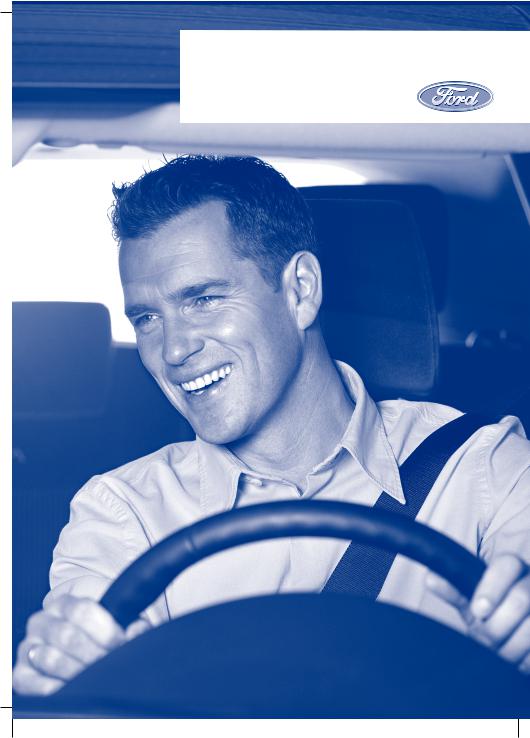
FordFiesta |
|
Feel the difference |
|
|
|||
Owner'shandbook |
|
|
|
|
|
|
|
|
|
|
|
|
|
|
|
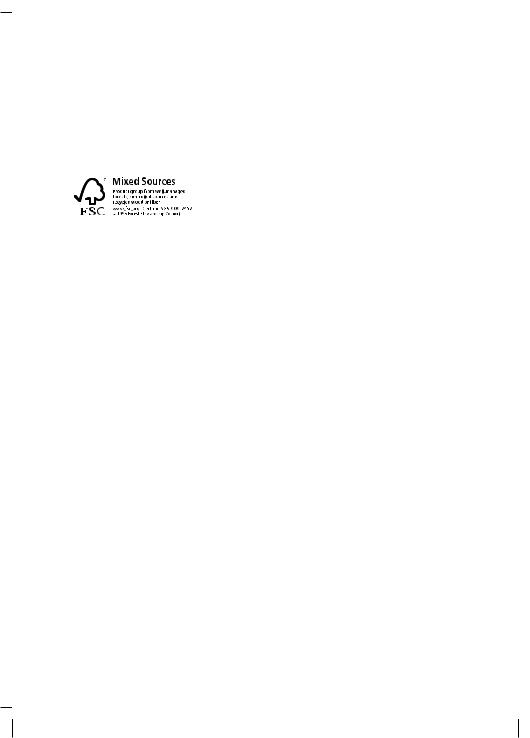
The information contained in this publication was correct at the time of going to print. In the interest of development the right is reserved to change specifications, design or equipment at any time without notice and without incurring any obligations. This publication, or part thereof, may not be reproduced nor translated without our approval. Errors and omissions excepted.
© Ford Motor Company 2009
All rights reserved.
Part number: 9V2J-19A321-ADA (CG3545en) 08/2009 20090911091511

Table of contents
Introduction |
|
About this handbook................................ |
5 |
Symbols glossary...................................... |
5 |
Parts and accessories.............................. |
5 |
Alarm |
|
Principle of operation |
..............................36 |
Arming the alarm..................................... |
36 |
Disarming the alarm................................ |
36 |
Quick start |
|
Quick start.................................................. |
8 |
Child safety |
|
Child seats................................................. |
17 |
Child seat positioning.............................. |
18 |
Booster cushions.................................... |
20 |
ISOFIX anchor points............................... |
21 |
Child safety locks.................................... |
22 |
Occupant protection |
|
Principle of operation.............................. |
23 |
Fastening the seat belts........................ |
25 |
Seat belt height adjustment.................. |
26 |
Seat belt reminder.................................. |
26 |
Using seat belts during pregnancy...... |
26 |
Disabling the passenger airbag............ |
26 |
Keys and remote controls |
|
General information on radio |
|
frequencies.......................................... |
28 |
Programming the remote control........ |
28 |
Changing the remote control |
|
battery................................................... |
28 |
Locks |
|
Locking and unlocking........................... |
30 |
Keyless entry........................................... |
32 |
Engine immobiliser |
|
Principle of operation.............................. |
35 |
Coded keys............................................. |
35 |
Arming the engine immobiliser............. |
35 |
Disarming the engine immobiliser........ |
35 |
Steering wheel |
|
Adjusting the steering wheel................. |
37 |
Audio control............................................ |
37 |
Voice control............................................ |
38 |
Wipers and washers |
|
Windscreen wipers................................. |
39 |
Windscreen washers............................. |
40 |
Rear window wiper and washers......... |
41 |
Adjusting the windscreen washer |
|
jets......................................................... |
42 |
Checking the wiper blades................... |
42 |
Changing the wiper blades................... |
42 |
Lighting |
|
Lighting control........................................ |
44 |
Autolamps................................................ |
45 |
Front fog lamps....................................... |
45 |
Rear fog lamps........................................ |
45 |
Headlamp levelling.................................. |
45 |
Hazard warning flashers........................ |
46 |
Direction indicators................................. |
46 |
Interior lamps........................................... |
46 |
Removing a headlamp........................... |
47 |
Changing a bulb...................................... |
47 |
Bulb specification chart.......................... |
52 |
Windows and mirrors |
|
Electric windows..................................... |
53 |
Exterior mirrors........................................ |
54 |
Electric exterior mirrors.......................... |
54 |
Auto-dimming mirror.............................. |
55 |
1

Table of contents
Instruments |
|
Gauges..................................................... |
56 |
Warning lamps and indicators.............. |
56 |
Audible warnings and indicators.......... |
59 |
Information displays |
|
General information................................. |
61 |
Trip computer.......................................... |
65 |
Personalised settings............................. |
65 |
Information messages........................... |
66 |
Climate control |
|
Principle of operation.............................. |
70 |
Air vents.................................................... |
70 |
Manual climate control............................ |
71 |
Automatic climate control...................... |
73 |
Heated windows and mirrors................ |
75 |
Seats |
|
Sitting in the correct position................. |
76 |
Head restraints........................................ |
76 |
Manual seats............................................ |
77 |
Rear seats................................................ |
78 |
Heated seats........................................... |
78 |
Keyless starting....................................... |
84 |
Steering wheel lock................................ |
85 |
Starting a petrol engine.......................... |
85 |
Starting a diesel engine.......................... |
86 |
Diesel particulate filter (DPF).................. |
87 |
Fuel and refuelling |
|
Safety precautions.................................. |
88 |
Fuel quality - Petrol................................. |
88 |
Fuel quality - Diesel................................. |
88 |
Fuel filler flap............................................. |
88 |
Catalytic converter.................................. |
89 |
Refuelling.................................................. |
89 |
Fuel consumption................................... |
89 |
Technical specifications......................... |
90 |
Transmission |
|
Manual transmission............................... |
91 |
Automatic transmission.......................... |
91 |
Brakes |
|
Principle of operation.............................. |
94 |
Hints on driving with ABS....................... |
94 |
Parking brake........................................... |
94 |
Convenience features |
|
Sun visors................................................. |
80 |
Clock......................................................... |
80 |
Cup holders............................................. |
80 |
Cigar lighter.............................................. |
80 |
Storage compartments......................... |
80 |
Map pockets............................................ |
81 |
Toll reader.................................................. |
81 |
Auxiliary input (AUX IN) socket.............. |
82 |
USB port................................................... |
82 |
Satellite navigation unit holder.............. |
82 |
Starting the engine |
|
General information................................ |
84 |
Stability control |
|
Principle of operation.............................. |
95 |
Using stability control.............................. |
95 |
Parking aid |
|
Principle of operation.............................. |
96 |
Using the parking aid - Vehicles With: |
|
Rear Parking Aid.................................. |
96 |
Using the parking aid - Vehicles With: |
|
Front and Rear Parking Aid................ |
97 |
Cruise control |
|
Principle of operation.............................. |
98 |
Using cruise control................................ |
98 |
2

Table of contents
Load carrying |
|
General information.............................. |
100 |
Luggage covers.................................... |
100 |
Roof racks and load carriers............... |
100 |
Towing |
|
Towing a trailer........................................ |
101 |
Detachable tow ball............................... |
101 |
Driving hints |
|
Running-in.............................................. |
105 |
Cold weather precautions................... |
105 |
Driving through water........................... |
105 |
Emergency equipment |
|
First aid kit............................................... |
106 |
Warning triangle..................................... |
106 |
Fuses |
|
Fuse box locations................................ |
107 |
Changing a fuse..................................... |
107 |
Fuse specification chart....................... |
108 |
Vehicle recovery |
|
Towing points.......................................... |
115 |
Towing the vehicle on four wheels...... |
115 |
Maintenance |
|
General information............................... |
117 |
Opening and closing the bonnet......... |
117 |
Engine compartment overview - 1.25L |
|
Duratec-16V (Sigma)/1.4L |
|
Duratec-16V (Sigma).......................... |
119 |
Engine compartment overview - 1.6L |
|
Duratec-16V Ti-VCT (Sigma)............ |
120 |
Engine compartment overview - 1.4L |
|
Duratorq-TDCi (DV) Diesel................ |
121 |
Engine compartment overview - 1.6L |
|
Duratorq-TDCi (DV) Diesel............... |
123 |
Engine oil dipstick - 1.25L Duratec-16V |
|
(Sigma)/1.4L Duratec-16V |
|
(Sigma)/1.6L Duratec-16V Ti-VCT |
|
(Sigma)................................................ |
124 |
Engine oil dipstick - 1.4L Duratorq-TDCi |
|
(DV) Diesel/1.6L Duratorq-TDCi (DV) |
|
Diesel................................................... |
124 |
Engine oil check..................................... |
124 |
Engine coolant check........................... |
125 |
Washer fluid check................................ |
125 |
Brake and clutch fluid check............... |
125 |
Technical specifications........................ |
126 |
Vehicle care |
|
Cleaning the exterior............................ |
129 |
Cleaning the interior.............................. |
129 |
Repairing minor paint damage............ |
130 |
Vehicle battery |
|
Using booster cables............................. |
131 |
Battery connection points................... |
132 |
Wheels and tyres |
|
General information.............................. |
133 |
Changing a road wheel........................ |
133 |
Tyre repair kit.......................................... |
138 |
Tyre care.................................................. |
141 |
Using winter tyres.................................. |
142 |
Using snow chains................................ |
142 |
Technical specifications........................ |
142 |
Vehicle identification |
|
Vehicle identification plate.................... |
146 |
Vehicle identification number (VIN)..... |
146 |
Technical specifications |
|
Technical specifications........................ |
147 |
Audio unit overview |
|
Audio unit overview................................ |
151 |
3

Table of contents
Audio system security |
|
Security code......................................... |
155 |
Audio unit operation |
|
On/off control......................................... |
156 |
Bass/treble control................................ |
156 |
Balance/fade control............................ |
156 |
Waveband button................................. |
156 |
Station tuning control............................ |
156 |
Station preset buttons.......................... |
157 |
Autostore control................................... |
157 |
Traffic information control..................... |
157 |
Audio unit menus |
|
Automatic volume control.................... |
159 |
Regional mode (REG)........................... |
159 |
Alternative frequencies......................... |
159 |
News broadcasts.................................. |
160 |
Compact disc player |
|
Compact disc playback........................ |
161 |
Track selection........................................ |
161 |
Fast forward/reverse............................. |
161 |
Shuffle/random....................................... |
161 |
Repeat compact disc tracks................ |
161 |
Compact disc track scanning............. |
162 |
MP3 file playback.................................. |
162 |
MP3 display options.............................. |
164 |
Ending compact disc playback........... |
164 |
Auxiliary input (AUX IN) |
|
socket |
|
Auxiliary input (AUX IN) socket............ |
165 |
Audio troubleshooting |
|
Audio troubleshooting.......................... |
166 |
Telephone |
|
General information............................... |
167 |
Telephone setup.................................... |
167 |
Bluetooth setup..................................... |
168 |
Telephone controls............................... |
168 |
Using the telephone.............................. |
169 |
Voice control |
|
Principle of operation............................. |
171 |
Using voice control................................. |
171 |
Audio unit commands........................... |
172 |
Telephone commands......................... |
180 |
Climate control commands................. |
184 |
Connectivity |
|
General information............................... |
187 |
Connecting an external device........... |
188 |
Using a USB device............................... |
188 |
Using an iPod......................................... |
189 |
Navigation introduction |
|
Road Safety............................................. |
191 |
Navigation system |
|
Getting started....................................... |
192 |
Appendices |
|
Type approvals...................................... |
194 |
Type approvals...................................... |
194 |
Type approvals...................................... |
194 |
Electromagnetic compatibility............. |
195 |
4
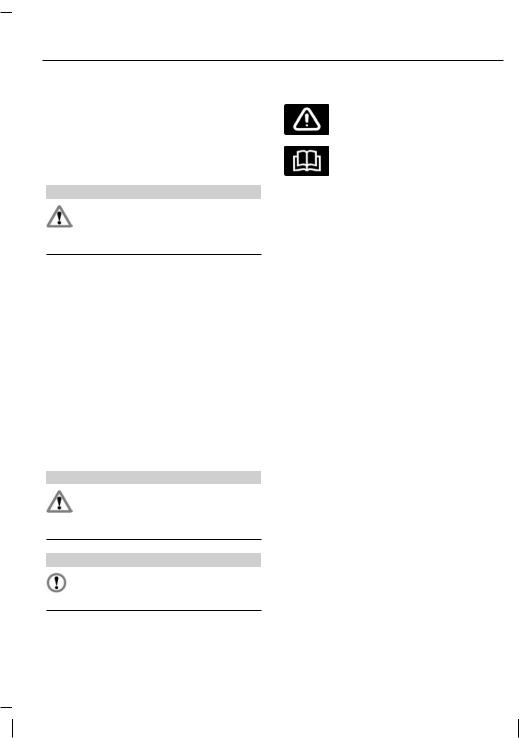
Introduction
ABOUT THIS HANDBOOK |
Symbols on your vehicle |
Thank you for choosing Ford. We recommend that you take some time to get to know your vehicle by reading this handbook.Themorethatyouknowabout it, the greater the safety and pleasure you will get from driving it.
WARNING
Always drive with due care and attention when using and operating the controls and features on your
vehicle.
Note: This handbook describes product features and options available throughout the range, sometimes even before they are generally available. It may describe options not fitted to your vehicle.
Note: Always use and operate your vehicle in line with all applicable laws and regulations.
Note: Pass on this handbook when selling your vehicle. It is an integral part of the vehicle.
SYMBOLS GLOSSARY
Symbols in this handbook
WARNING
You risk death or serious injury to yourself and others if you do not follow the instructions highlighted
by the warning symbol.
CAUTION
You risk damaging your vehicle if you do not follow the instructions highlighted by the caution symbol.
When you see these symbols, read and follow the relevant instructions in this handbook before touching or attempting adjustment of any kind.
PARTS AND ACCESSORIES
Now you can be sure that your Ford parts are Ford parts
Your Ford has been built to the highest standards using high quality Ford Original Parts. As a result, you can enjoy driving it for many years.
Should the unexpected occur and a major partneedsreplacing,werecommendthat you accept nothing less than Ford Original Parts.
The use of Ford Original Parts ensures that your vehicle is repaired to its pre-accident condition and maintains its maximum residual value.
Ford Original Parts match Ford's stringent safety requirements and high standards of fit, finish and reliability. Quite simply, they represent the best overall repair value, including parts and labour costs.
Now it is easier to tell if you have really been given Ford Original Parts. The Ford logo is clearly visible on the following parts if they are Ford Original Parts. If your vehicle has to be repaired, look for the clearly visible Ford branding and make sure that only Ford Original Parts have been used.
5

Introduction
Look for the Ford logo on the following parts
Sheet metal
•Bonnet
•Wing
• Doors
• Luggage compartment lid
E102436
Exterior mirror
E102435
Bumper and radiator grille
•Radiator grille
• |
Front and rear bumper |
E102437 |
|
Glass
• Rear window
• Side glass
• Windscreen
6

Introduction
E89939
Lighting
•Rear lamps
•Headlamp
E102438
7

Quick start
QUICK START
Instrument panel overview
Left-hand drive
A B C D E F G H
S R Q P O N M L K J I
E102562
8

Quick start
Right-hand drive
H G F B D C E A
I J L K Q O P M N R S
E102559
AAir vents. See Air vents (page 70).
BMulti-function lever: Direction indicators. See Direction indicators (page 46). Main beam. See Lighting control (page 44). See Voice control (page 38). See Trip computer (page 65).
CInstrument cluster. See Gauges (page 56). See Warning lamps and indicators (page 56).
DStart button. See Keyless starting (page 84).
E Wiper lever. See Wipers and washers (page 39).
FMulti functional display.
GAudio unit. See Audio unit overview (page 151).
9
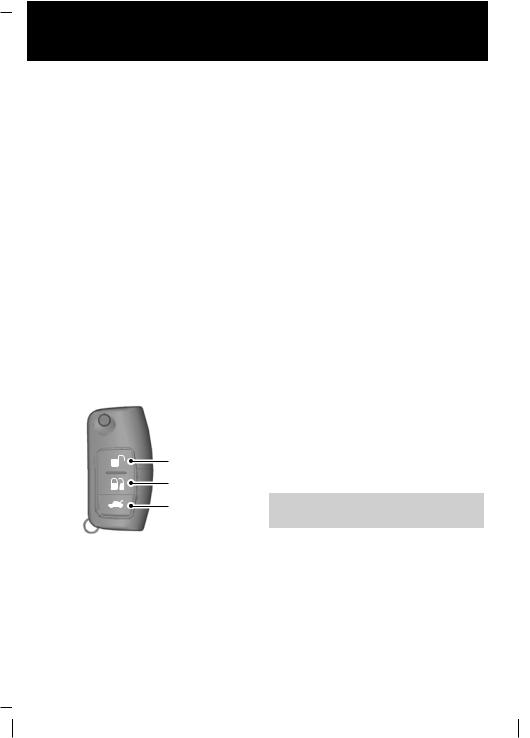
Quick start
HDoor lock button. See Locking and unlocking (page 30).
I Hazard warning flasher switch. See Hazard warning flashers (page 46).
JClimate controls. See Climate control (page 70).
KCard holder. or Parking aid warning lamp or switch. See Parking aid (page 96).
LCard holder. or Passenger airbag deactivation warning lamp. See Disabling the passenger airbag (page 26).
MIgnition switch.
NCruise control. See Using cruise control (page 98).
OHorn.
P Steering wheel adjustment. See Adjustingthesteeringwheel (page 37).
QAudio control. See Audio control (page 37).
RBonnet release lever. See Opening and closing the bonnet (page 117).
SLighting control. See Lighting control (page 44). Front fog lamps. See Front fog lamps (page 45). Rear fog lamp. See Rear fog lamps (page 45).
Locking and unlocking
Unlocking the vehicle
A
B
C
E71963
AUnlock
BLock
CLuggage compartment lid unlock
Press the unlock button once to unlock the vehicle. See Programming the remote control (page 28).
Press the lock button once to activate central locking.
Press the lock button twice within three seconds to activate double locking.
Presstheluggagecompartmentlidunlock button twice within three seconds to unlock the luggage compartment.
See Locking and unlocking (page 30).
10

Quick start
Keyless entry |
Unlocking the vehicle |
E78276
Passive locking and unlocking requires a valid passive key to be located within one of the three external detection ranges.
Locking the vehicle
E87384
Locking buttons are located on each of the front doors.
Press a locking button once.
E87384
Press a locking button once.
See Keyless entry (page 32).
Keyless starting
E85766
Press the start button once.
Starting with automatic transmission
Note: Releasing the brake pedal during engine start will stop the engine cranking and return to ignition on.
1.Make sure the transmission is in P or
N.
2.Fully depress the brake pedal.
3.Briefly press the start button.
Starting with manual transmission
Note: Releasing the clutch pedal during engine start will stop the engine cranking and return to ignition on.
11

Quick start
1.Fully depress the clutch pedal.
2.Briefly press the start button.
See Keyless starting (page 84).
Adjusting the steering wheel
WARNING
Never adjust the steering wheel when the vehicle is moving.
2 
2
 1
1
E95178
WARNING
Make sure that you fully engage the locking lever when returning it to its original position.
 3
3
E95179
See Adjusting the steering wheel
(page 37).
Manual climate control
Recommendedsettingsforcooling
E112145
Open the centre and side air vents.
Direct the centre air vents upwards and the side air vents toward the side windows.
12
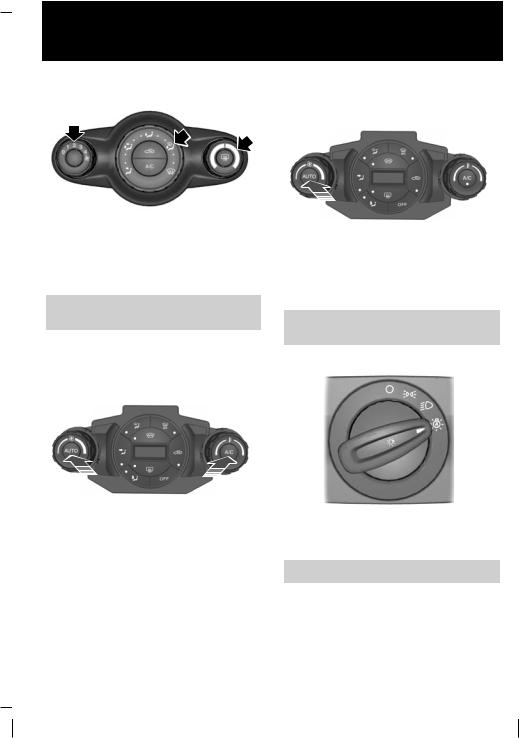
Quick start
Recommendedsettingsforheating Recommendedsettingsforheating
E112146
Close the centre air vents and open the side air vents.
Direct the side air vents toward the side windows.
See Manual climate control (page 71).
Automatic climate control
Recommendedsettingsforcooling
E112147
Set the temperature to 22°C (72°F).
Open the centre and side air vents.
Direct the centre air vents upwards and the side air vents toward the side windows.
E112148
Set the temperature to 22°C (72°F).
Open the centre and side air vents.
Direct the centre air vents upwards and the side air vents toward the side windows.
See Automatic climate control
(page 73).
Autolamps
E70719
The headlamps will come on and go off automatically depending on the ambient light.
See Lighting control (page 44).
13
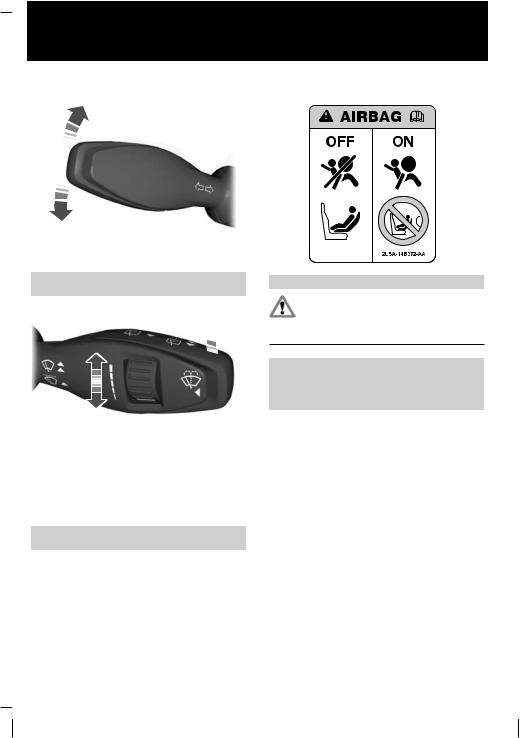
Quick start
Direction indicators |
Airbag |
E102016
If the lever is tapped up or down, the direction indicators will flash three times.
See Direction indicators (page 46).
Autowipers
 B
B
E102034
Move the lever up one position.
The rain sensor will continuously measure the amount of water on the windscreen and adjust the speed of the front wipers automatically.
Adjust the sensitivity of the rain sensor using the rotary control.
See Windscreen wipers (page 39).
E69213
WARNING
To avoid the risk of death or serious injury, never use a rearward facing child restraint in the front, unless the
air bag is off.
See Child safety (page 17).
See Disabling the passenger airbag (page 26).
14
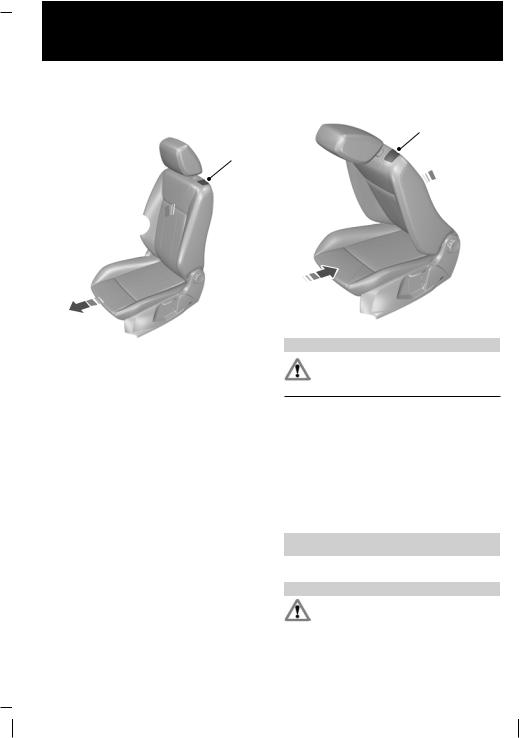
Quick start
Manual seats
Folding the seatback forwards - 3-door
1
2 
3
E112675
1.Pull the locking lever to release the seatback.
Note: Do not hold the locking lever.
2.Push the seatback forwards to lock it in the folded position.
3.Continue to push the seatback to slide the seat forwards.
Returning the seatback to the seating position - 3-door
2
 3
3
1
E112676
WARNING
Do not place any objects behind the seatback which could prevent the engagement of the seat lock.
1.Slide the seat backwards to the end stop (memory position) or desired forward seating position.
Note: The memory function is only available on the driver's seat.
2.Pull the locking lever to release the seatback.
3.Unfold the seatback until it locks with a distinct click.
See Manual seats (page 77).
Fuel filler flap
WARNINGS
Take care when refuelling to avoid spilling any residual fuel from the fuel pipe nozzle.
15

Quick start
WARNINGS
We recommend that you wait at least 10 seconds before removing the fuel pipe nozzle to allow any
residual fuel to drain into the fuel tank.
E103203
Press the flap to open it. Open the flap fully until it engages.
When you insert the fuel pipe nozzle, a spring loaded inhibitor will open if the correct size nozzle is detected. This will prevent filling up with the wrong fuel.
E107539
Insert the fuel pipe nozzle up to the first notch on the nozzle, and keep it in position on the fuel filler opening.
See Fuel filler flap (page 88).
16

Child safety
CHILD SEATS |
Only child restraints certified to |
|
ECE-R44.03 (or later) have been tested |
|
and approved for use in your vehicle. A |
|
choice of these are available from your |
|
Dealer. |
|
Child restraints for different |
|
mass groups |
|
Use the correct child restraint as follows: |
|
Baby safety seat |
E68916
WARNINGS
Secure children that are less than 150 centimetres tall or less than 12 years of age in a suitable, approved
child restraint, in the rear seat.
Original text according to ECE R94.01: ExtremeHazard!Do not use a rearward facing child restraint on
a seat protected by an air bag in front of it!
Read and follow the manufacturer’s instructions when you are fitting a child restraint.
Do not modify child restraints in any way.
Do not hold a child on your lap when the vehicle is moving.
Do not leave unattended children in your vehicle.
If your vehicle has been involved in an accident, have the child restraints checked by properly trained
technicians.
Note: Mandatory use of child restraints varies from country to country.
E68918
Secure children that weigh less than 13 kilograms in a rearward facing baby safety seat (Group 0+) in the rear seat.
17

Child safety
Child safety seat
E68920
Secure children that weigh between 13 and 18 kilograms in a child safety seat (Group 1) in the rear seat.
CHILD SEAT POSITIONING
WARNINGS
When using a child seat with a support leg, the support leg must rest securely on the floor.
When using a child seat with a seat belt, make sure that the seat belt is not slack or twisted.
CAUTION
The child seat must rest tightly against the vehicle seat. It may be necessary to lift or remove the head
restraint. See Head restraints (page 76).
Note: When using a child seat on a front seat, it may prove difficult to tighten the lap section of the seat belt without slack remaining. If this is the case, adjust the seatback to the fully upright position and raise the height of the seat. See Seats (page 76).
Seating positions |
|
Mass group categories |
|
||
|
0 |
0+ |
1 |
2 |
3 |
|
Up to 10 |
Up to 13 |
9 - 18 kg |
15 - 25 kg |
22 - 36 kg |
|
kg |
kg |
|
|
|
Front passenger seat |
X |
X |
UF¹ |
UF¹ |
UF¹ |
with airbag ON |
|
|
|
|
|
Front passenger seat |
U¹ |
U¹ |
U¹ |
U¹ |
U¹ |
with airbag OFF |
|
|
|
|
|
Rear seats |
U |
U |
U |
U |
U |
X Not suitable for children in this mass group.
U Suitable for universal category child seats approved for use in this mass group.
U¹ Suitable for universal category child seats approved for use in this mass group. However, we recommend that you secure children in a government approved child seat, in the rear seat.
18

Child safety
UF¹ Suitable for universal category forward facing child seats approved for use in this mass group. However, we recommend that you secure children in a government approved child seat, in the rear seat.
ISOFIX child seats
Seating positions |
|
Mass group categories |
|
|
|
0 |
|
0+ |
1 |
|
Up to 10 kg |
Up to 13 kg |
9 - 18 kg |
|
Rear seat ISOFIX seats |
IL |
|
IL |
IL, IUF** |
Rear seat ISOFIX classes* |
E |
|
E |
B, B1 |
IUF Suitable for universal category ISOFIX child seats approved for use in this mass group.
IL Suitable for the following ISOFIX child seats: Roemer Duo ISOFIX (group 1), Roemer Babysafe ISOFIX (group 0+). In addition, any semi-universal ISOFIX child seat may be used if indicated in the child seat manufacturers vehicle list.
Note: * As defined by ECE-R16.
Note: ** When you are purchasing an ISOFIX seat, make sure that you know the correct mass group and ISOFIX size class for the intended seating locations.
Note: ** Make sure that the top tether mechanism does not interfere with the luggage cover.
19

Child safety
BOOSTER CUSHIONS
WARNINGS
Do not install a booster seat or a booster cushion with only the lap strap of the seat belt.
Do not install a booster seat or a booster cushion with a seat belt that is slack or twisted.
Do not put the seat belt under your child’s arm or behind its back.
Do not use pillows, books or towels to boost your child’s height.
Make sure that your children sit in an upright position.
Secure children that weigh more than 15 kilograms but are less than 150 centimetres tall in a booster
seat or a booster cushion.
CAUTION
When using a child seat on a rear seat, make sure that the child seat rests tightly against the vehicle seat.
It may be necessary to lift or remove the head restraint. See Head restraints (page 76).
Booster seat (Group 2)
E70710
We recommend that you use a booster seat that combines a cushion with a backrest instead of a booster cushion only. The raised seating position will allow you to position the shoulder strap of the adult seat belt over the centre of your child’s shoulder and the lap strap tightly across its hips.
Booster cushion (Group 3)
E68924
20

Child safety
ISOFIX ANCHOR POINTS
WARNING
Use an anti-rotation device when using the ISOFIX system. We recommend the use of a top tether
or support leg.
Your vehicle is fitted with ISOFIX anchor points that accommodate universally approved ISOFIX child seats.
The ISOFIX system comprises of two rigid attachment arms on the child seat that attach to anchor points on the outboard rear seats, where the cushion and backrest meet. Tether anchor points are fitted behind the outboard rear seats for child seats with a top tether.
Top tether anchor points
E87146
Attaching a child seat with top tethers
WARNING
Do not attach a tether strap to anything other than the correct tether anchor point.
Note: Where applicable, remove the luggage cover to ease installation. See
Luggage covers (page 100).
E87591
1.Place the child seat on the back seat cushion and fold the relevant seatback forwards. See Rearseats(page 78).
2.Remove the head restraint. See
Head restraints (page 76).
WARNING
Make sure the top tether strap is not slack or twisted and is properly located on the anchor point.
3.Route the tether strap to the anchor point.
WARNING
Make sure that the seatback is secure and fully engaged in the catch.
4.Push the seatback to the upright position.
21

Child safety
E87145
5.Push the child seat back firmly to engage the ISOFIX lower anchor points.
6.Tighten the tether strap in line with the child seat manufacturer's instructions.
CHILD SAFETY LOCKS
WARNING
You cannot open the doors from inside if you have put the child safety locks on.
E112197
Left-hand side
Turn anti-clockwise to lock and clockwise to unlock.
Right-hand side
Turn clockwise to lock and anti-clockwise to unlock.
22

Occupant protection
PRINCIPLE OF OPERATION
Airbags
WARNINGS
Do not modify the front of your vehicle in any way. This could adversely affect deployment of the
airbags.
Original text according to ECE R94.01: ExtremeHazard!Do not use a rearward facing child restraint on
a seat protected by an airbag in front of it!
Wear a seat belt and keep sufficient distance between yourself and the steering wheel. Only when you use the seat belt properly, can it hold you in a
position that allows the airbag to achieve its optimum effect. See Sitting in the correct position (page 76).
Have repairs to the steering wheel, steering column, seats, airbags and seat belts carried out by a properly
trained technician.
Keep the areas in front of the airbags free from obstruction. Do not affix anything to or over the
airbag covers.
Do not poke sharp objects into areas where airbags are fitted. This could damage and adversely affect
deployment of the airbags.
Use seat covers designed for seats with side airbags. Have these fitted by a properly trained technician.
Note: You will hear a loud bang and see a cloud of harmless powdery residue if an airbag deploys. This is normal.
Note: Only wipe airbag covers with a damp cloth.
Driverandfrontpassengerairbags
E74302
The driver and front passenger airbags will deploy during significant frontal collisions or collisions that are up to 30 degrees from the left or the right. The airbags will inflate within a few thousandths of a second and deflate on contact with the occupants, thus cushioning forward body movement. During minor frontal collisions, overturns, rear collisions and side collisions, the driver and front passenger airbags will not deploy.
Driver knee airbag
CAUTION
Do not attempt to open the driver knee airbag cover.
The driver knee airbag will deploy during frontal collisions or collisions that are up to 30 degrees from the left or the right. The airbag will inflate within a few thousandths of a second and deflate on contact with the occupants, thus providing a cushion between the driver’s knees and the steering column. During overturns, rear collisions and side collisions, the knee airbag will not deploy.
For item location: See Quickstart(page 8).
23
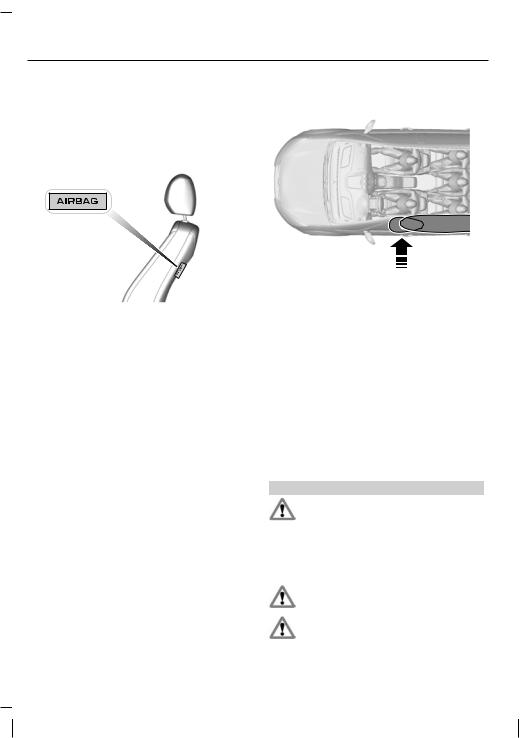
Occupant protection
Note: The knee airbag has a lower deployment threshold than the front airbags. During a minor collision, it is possible that only the knee airbag deploys.
Side airbags
E72658
Side airbags are fitted inside the seatback of the front seats. A label indicates that side airbags are fitted to your vehicle.
The side airbags will deploy during significant lateral collisions. The airbags will inflate within a few thousandths of a second and deflate on contact with the occupants, thus providing protection for the chest and shoulder areas. During minor lateral collisions, overturns, front collisions and rear collisions, the side airbags will not deploy.
Curtain airbags
E75004
Curtain airbags are fitted inside the trim panels over the front and rear side windows. Moulded badges in the B-pillar trim panels indicate that curtain airbags are fitted to your vehicle.
The curtain airbags will deploy during significant lateral collisions. The airbag will inflate within a few thousandths of a second and deflate on contact with the occupants, thus providing protection for the head. During minor lateral collisions, front collisions, rear collisions, or overturns the curtain airbags will not deploy.
Seat belts
WARNINGS
Wear a seat belt and keep sufficient distance between yourself and the steering wheel. Only when you use the seat belt properly, can it hold you in a
position to achieve its optimum effect. See Sitting in the correct position
(page 76).
Never use a seat belt for more than one person.
Use the correct buckle for each seat belt.
24

Occupant protection
WARNINGS
Do not use a seat belt that is slack or twisted.
Do not wear thick clothing. The seat belt must fit tightly around your body to achieve its optimum effect.
Position the shoulder strap of the seat belt over the centre of your shoulder and position the lap strap
tightly across your hips.
The driver and front passenger seat belt retractors are fitted with a seat belt pretensioner. Seat belt pretensioners have a lower deployment threshold than the airbags. During minor collisions, it is possible that only the seat belt pretensioners will deploy.
Status after a collision
WARNING
Seat belts subjected to strain, as a result of an accident, should be renewed and the anchorages
checked by a properly trained technician.
FASTENING THE SEAT BELTS
WARNING
Insert the tongue into the buckle until you hear a distinct click. You have not fastened the seat belt
properly if you do not hear a click.
E74124
E85817
Pull the belt out steadily. It may lock if you pull it sharply or if the vehicle is on a slope.
Press the red button on the buckle to release the belt. Let it retract completely and smoothly.
25

Occupant protection
SEAT BELT HEIGHT
ADJUSTMENT
E104440
Note: Lifting the slider slightly while pressing the locking button makes it easier to release the locking mechanism.
To raise or lower, press the locking button on the adjuster and move as necessary.
SEAT BELT REMINDER
WARNING
The occupant protection system will only provide optimum protection when you use the seat belt properly.
The seat belt reminder warning
lamp illuminates and an audible warning will sound if the driver's
or front seat passenger's seat belt has not been fastened and the vehicle exceeds a relatively low speed. It will also illuminate if the driver's or front seat passenger's seat belt is unfastened when the vehicle is moving. The audible warning will go off after five minutes but the seat belt reminder warning lamp will remain on until the driver's or front seat passenger's seat belt is fastened.
Deactivating the seat belt reminder
See your dealer.
USINGSEATBELTSDURING PREGNANCY
E68587
WARNING
Position the seat belt correctly for your safety and that of your unborn child. Do not use only the lap strap
or the shoulder strap.
Position the lap strap comfortably across your hips and low beneath your pregnant abdomen. Position the shoulder strap between your breasts, above and to the side of your pregnant abdomen.
DISABLING THE PASSENGER AIRBAG
WARNING
Make sure that the passenger airbag is disabled when using a rearward facing child restraint on the
front passenger seat.
26

Occupant protection
E71313
Fitting the passenger airbag deactivation switch
WARNING
If you need to fit a child restraint on a seat protected by an operational airbag in front of it, have a
passenger airbag deactivation switch fitted. Ask your dealer for further information.
Note: The key switch is located in the glove compartment with an airbag deactivation lamp in the instrument panel.
If the airbag warning lamp illuminates or flashes when you are driving, this indicates a malfunction. See Warninglampsand indicators (page 56). Remove the child restraint and have the system checked immediately.
Disablingthepassengerairbag
AB
E71312
A Disabled
BEnabled
Turn the switch to position A.
When you switch the ignition on, check that the passenger airbag deactivation warning lamp illuminates.
Enablingthepassengerairbag
WARNING
Make sure that the passenger airbag is enabled when you are not using a child restraint on the front
passenger seat.
Turn the switch to position B.
27

Keys and remote controls
GENERALINFORMATIONON RADIO FREQUENCIES
CAUTION
The radio frequency used by your remote control can also be used by other short distance radio
transmissions (e.g. amateur radios, medicalequipment,wirelessheadphones, remote controls and alarm systems). If the frequencies are jammed, you will not be able to use your remote control. You can lock and unlock the doors with the key.
Note: You could unlock the doors if you press the buttons on the remote control unintentionally.
The operating range between your remote control and your vehicle varies depending on the environment.
PROGRAMMING THE REMOTE CONTROL
You can programme a maximum of eight remote controls to use with your vehicle (including any supplied with your vehicle). Ask your dealer for instructions.
CHANGING THE REMOTE CONTROL BATTERY
Make sure that you dispose of old batteries in an environmentally friendly way.
Seek advice from your local authority regarding recycling.
Remote control with a folding key blade
 1
1
E74383
1.Insert a screwdriver as far as possible into the slot on the side of the remote control, push it towards the key blade and remove the key blade.
2
E74384
2.Twist the screwdriver in the position shown to start separating the two halves of the remote control.
28
